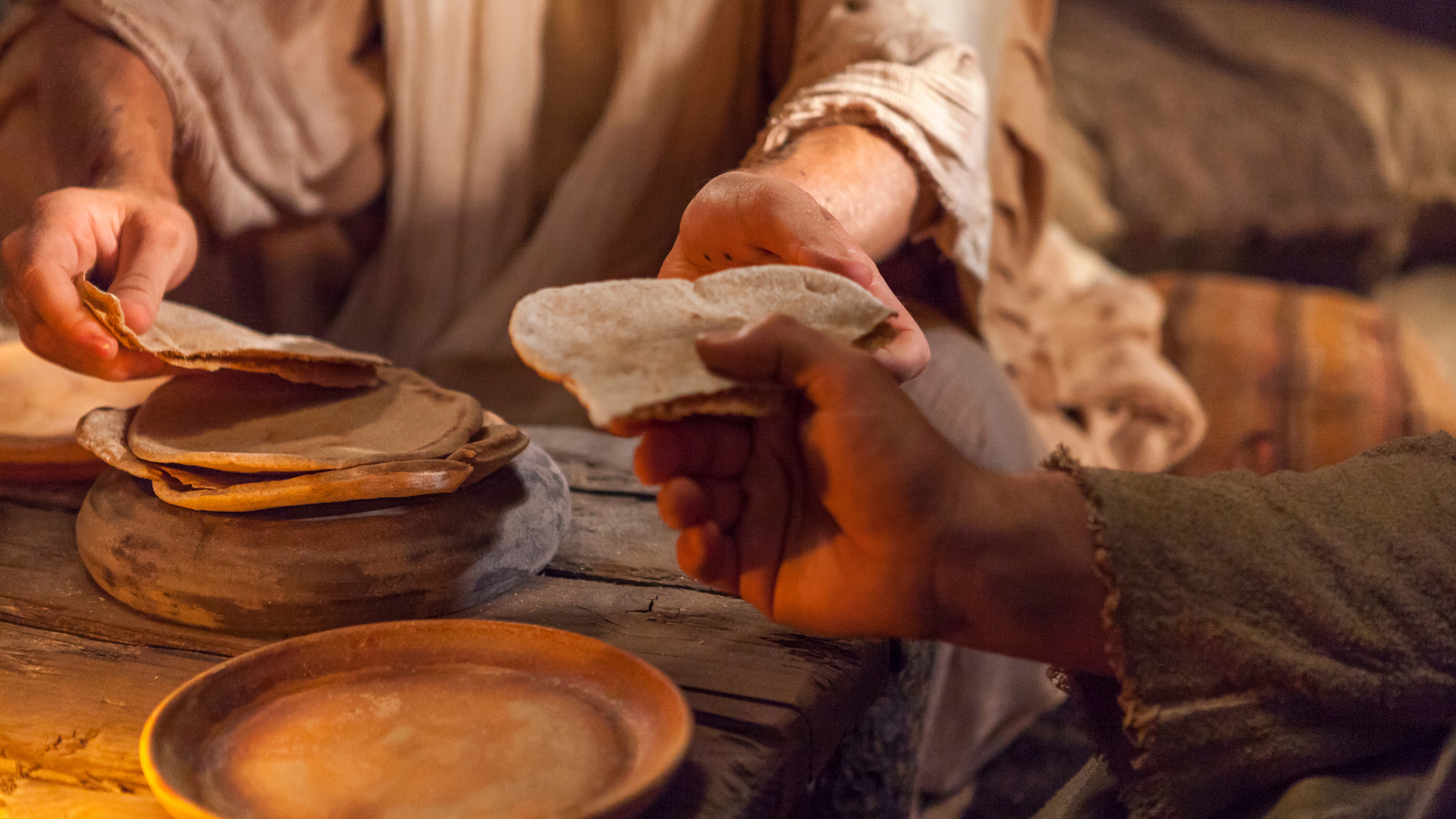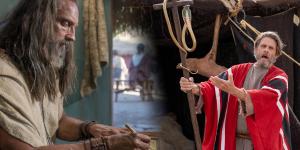You are here
Why Did Jesus Use Passover Imagery in His Bread of Life Sermon?

John 6:35
The Know
According to the Gospel of John, Jesus offered a powerful sermon as “the passover, a feast of the Jews, was nigh” (John 6:4). This discourse, often called the Bread of Life Sermon (John 6:25–58), relates to the Passover in several profound ways. As summarized by Eric D. Huntsman, “The Passover setting establishes some of the fundamental symbolism necessary for understanding the Bread of Life discourse, including deliverance, the crossing of the sea, miraculous feedings in the wilderness, and the saving role of the Paschal Lamb.”1
These Passover allusions arise well before Jesus even began His famous sermon. For instance, in John 6:3 we learn that Jesus “went up into a mountain, and there he sat with his disciples.” (John 6:3).2 Other Gospel accounts place this mountain in a “desert place.”3 This mountain-wilderness context echoes the wilderness through which the children of Israel wandered after the very first Passover as well as Mount Sinai, where they received the law of Moses (Exodus 12:11–13; 19:1–3).
In this setting, Jesus fed His disciples in addition to about five thousand people who had followed Him, which he accomplished by multiplying a few small loaves and fishes (John 6:9–12).4 This famous miracle, notes Huntsman, not only “re-creates the table fellowship of the Passover meal” but also harks back “to Jehovah’s provision of manna and flesh to the Israelites in the wilderness.”5 Having witnessed this miracle, many present clearly recognized Jesus as a “new Moses,”6 stating that “this is of a truth that prophet that should come into the world” who would be like Moses (John 6:14; as prophesied in Deuteronomy 18:15).
After these events, Jesus miraculously crossed the Sea of Galilee by literally walking upon it (John 6:19)—akin to the Israelites traversing through the Red Sea on dry ground (Exodus 14:21–22). While many viewed the coming Messiah as a prophetic king (see John 6:15), Jesus’s direct control over the elements showed that He possessed power typically attributed to Jehovah in the Old Testament.7
Jesus’s identity as Jehovah was further solidified when He approached His disciples in the boat, saying, “It is I; be not afraid” (John 6:20). The beginning of Jesus’s statement uses the Greek words for “I AM” (ego eimi); thus He was not saying “It is I” but “I AM, be not afraid.”8 This same expression was spoken by Jehovah to Moses when He declared “I AM THAT I AM” (Exodus 3:14) and is found fourteen other places throughout John’s Gospel and in a few more locations in the other three Gospels, identifying Jesus as the God of the Old Testament.9
Finally, as Jesus delivered a sermon to the multitude in Capernaum the following day, He stated, “I am the bread of life: he that cometh to me shall never hunger; and he that believeth on me shall never thirst” (John 6:35). When asked how His listeners might receive this bread, Jesus offered what was for many a shocking instruction: “Except ye eat the flesh of the Son of man, and drink his blood, ye have no life in you. Whoso eateth my flesh, and drinketh my blood, hath eternal life; and I will raise him up at the last day” (John 6:53–54).
Many in the crowd misunderstood or doubted the truthfulness of Jesus’s statement, just as many today might be puzzled by it.10 Yet, as Huntsman concluded, the “Exodus imagery of the discourse’s Passover setting provides an important, although often overlooked, image that connects this flesh and blood symbolism directly to the original discourse that Jesus delivered—namely, the Paschal Lamb which was sacrificed so that its blood would ward off death and whose flesh was eaten in a festive meal.”11
For modern Christians, including Latter-day Saints, partaking of the Bread of Life—and therefore the paschal lamb of God—is most recognizable through the ordinance of the sacrament. While the sacrament is often understood to be commemorative of Jesus’s Atonement, Huntsman proposes that it may also have a broader meaning, looking not only backward in time but forward also. The very “fact that [the sacrament] is to be celebrated specifically until He comes again … suggests that it can also, in a sense, be proleptic—anticipating His glorious return and foreshadowing the great end-time messianic feast.”12
When viewed in light of these additional doctrinal relationships, the sacrament can take on new and profound layers of meaning. As C. Wilfred Griggs observed, “the sacrament of the Lord’s Supper cannot be received without an awesome reverence—for by it he is in us, and we become one with him. Thus he prayed with those who supped with him prior to Gethsemane and the cross (John 17).”13
The Why
Elder Bruce R. McConkie taught that for the Latter-day Saints and all Christians today, “to eat the flesh and drink the blood of the Son of God is, first, to accept him in the most literal and full sense, with no reservation whatever, as the personal offspring in the flesh of the Eternal Father.”14 Working the works of God, Elder McConkie continued, means “keep[ing] the commandments of the Son by accepting his gospel, joining his Church, and enduring in obedience and righteousness unto the end.”15 At Passover in Jesus’s world, Jewish families acceptingly ate the unleavened bread and the flesh of the sacrificed lamb with gratitude for the deliverance from bondage and death in Egypt that Jehovah had given them.
Sadly, many who heard these teachings directly from Jesus Himself were unwilling to accept that He was the Bread of Life who had come from God (see John 6:66). While Christ is not directly ministering to humankind today, the opportunity for a deep interpersonal communion with Him and the Father is made possible each week through the ordinance of the sacrament. As we worthily participate in this sacred ordinance, we promise to take upon ourselves the name of Jesus Christ, to always remember Him (including His body and blood, which were given for us), and to always keep His commandments (see Doctrine and Covenants 20:77, 79). At Passover, Jewish families remember the giving of the law in the wilderness of Sinai, renewing commitments to keep the name of Jehovah hallowed and to walk continuously in the path of righteousness.
“As both a commemorative and a proleptic act,” Huntsman writes, “the celebration of the sacrament in Latter-day Saint theology therefore not only looks back to His atoning death, but also looks forward to the Resurrection—emphasizing the possibility of current and future communion with Him.”16 By staying true to the covenants we make with the Lord, we can have this hope, looking forward to the great messianic Passover feast when Jesus returns to the earth and ushers in the promised state of dwelling with the Father and Son in the eternities. As Jesus promised, “whoso eateth my flesh, and drinketh my blood, hath eternal life; and I will raise him up at the last day” (John 6:54).
Further Reading
Eric D. Huntsman, “The Bread of Life Sermon,” in Celebrating Easter: The 2006 BYU Easter Conference, ed. Thomas A. Wayment and Keith J. Wilson (Provo, UT: Religious Studies Center, Brigham Young University), 87–111.
Donald W. Parry, “Manna: Symbol of Jesus Christ,” in The Jesus Christ Focused Old Testament: Making Sense of a Monumental Book (Springville, UT: Book of Mormon Central, 2022), 126–127.
C. Wilfred Griggs, “The Tree of Life in John’s Gospel,” in The Tree of Life: From Eden to Eternity, ed. John W. Welch and Donald W. Parry (Provo, UT: Neal A. Maxwell Institute; Salt Lake City, UT: Deseret Book, 2011), 109–128.
- 1. Eric D. Huntsman, “The Bread of Life Sermon” in Celebrating Easter: The 2006 BYU Easter Conference, ed. Thomas A. Wayment and Keith J. Wilson (Provo, UT: Religious Studies Center, Brigham Young University), 89–90.
- 2. This mountain setting is notable because in other instances, Jesus visited Jerusalem at the time of the Passover. See John 2:23, 13:1.
- 3. See Matthew 14:15; Mark 6:31; Luke 9:10.
- 4. C. Wilfred Griggs notes that “the word for fish used in John is the diminutive form, emphasizing the small size” and, therefore, further highlighting the miraculous nature of this event. C. Wilfred Griggs, “The Tree of Life in John’s Gospel,” in The Tree of Life: From Eden to Eternity, ed. John W. Welch and Donald W. Parry (Provo, UT: Neal A. Maxwell Institute; Salt Lake City, UT: Deseret Book, 2011), 116.
- 5. Huntsman, “Bread of Life Sermon,” 90.
- 6. Huntsman, “Bread of Life Sermon,” 89.
- 7. See Job 9:8; 38:16; Habakkuk 3:15; Huntsman, “Bread of Life Sermon,” 90–91: “This miracle makes an important Christological statement, identifying Jesus directly with Jehovah. … Whereas the feeding miracle could be interpreted too narrowly, as a sign that Jesus was only a messianic king, His walking on the water and miraculous completion of the sea voyage serves as a sign that He was far more.”
- 8. See Huntsman, “Bread of Life Sermon,” 91.
- 9. For a summary of John’s use of this formula regarding Jesus’s divine identity, see Jackson Abhau, “Taking Away the Sin of the World: Egō Eimi and the Day of Atonement in John,” Studia Antiqua 19, no. 1 (2020): 43–58. For a complete listing of all uses of this expression in the New Testament, see John W. Welch, Charting the New Testament (Provo, UT: Foundation for Ancient Research and Mormon Studies, 2002), chart 8-1, https://archive.bookofmormoncentral.org/content/jesus-affirms-his-divinity.
- 10. John 6:41, 52, 60, 64.
- 11. See Huntsman, “Bread of Life Sermon,” 101.
- 12. Huntsman, “Bread of Life Sermon,” 101, citing 1 Corinthians 11:26; Matthew 26:29; Mark 14:25; Luke 22:18; Isaiah 25:6–8; Ezekiel 39:17–20; Zechariah 9:15; D&C 27:4–14. For more on the emphasis on Jesus’s Resurrection in the sacrament, especially as found in the Book of Mormon, see Book of Mormon Central, “Why Did the Savior Emphasize His Risen Body in the Nephite Sacrament? (3 Nephi 18:7),” KnoWhy 211 (October 18, 2016).
- 13. Griggs, “Tree of Life in John’s Gospel,” 119.
- 14. Bruce R. McConkie, Doctrinal New Testament Commentary, 3 vols. (Salt Lake City, UT: Bookcraft, 1988), 1:368.
- 15. McConkie, Doctrinal New Testament Commentary, 1:368.
- 16. Huntsman, “Bread of Life Sermon,” 102.
KnoWhy Citation
Related KnoWhys
Subscribe
Get the latest updates on Book of Mormon topics and research for free





